I’m on the advisory committee for The Thomas Jefferson Center for the Protection of Free Expression‘s free expression monument, which is being built on Charlottesville’s Downtown Mall, in front of City Hall. The structure of the monument — which is a large chalkboard — has been completed, but the slate is being mined in Buckingham right now. The chalkboard will not be unveiled until early spring. In the meantime, people have felt free to mark up the fabric-veiled surface with magic marker. Here are some of the renderings that I spotted last Sunday.
Comments are closed.

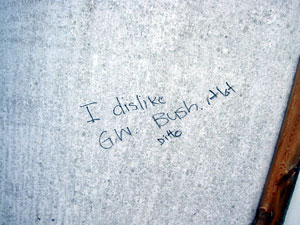
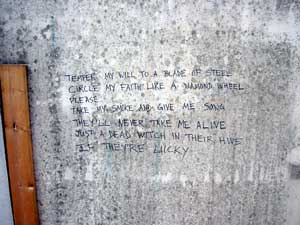
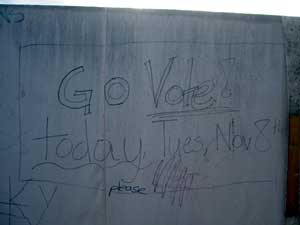
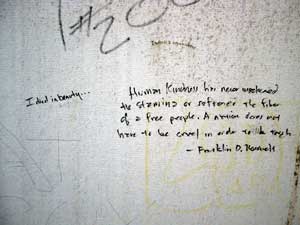
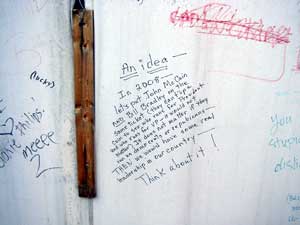
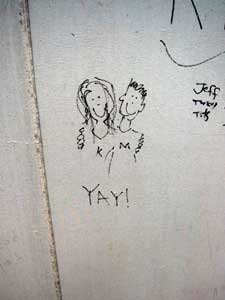
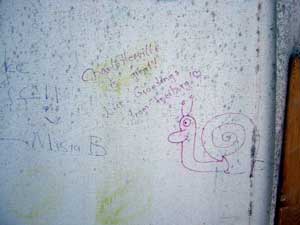
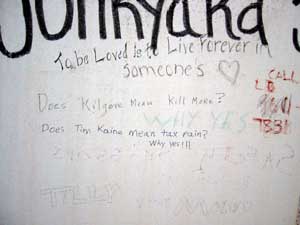
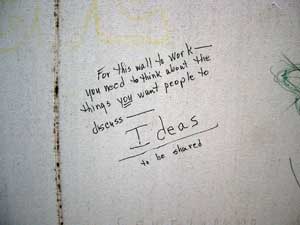
This is an outrage — shocking! — people are writing WHATEVER THEY WANT! Aarrggghhhh!
Will people indeed be allowed to write whatever they want on the finished monument? What courses of action has the advisory committee suggested to deal with content that is not otherwise protected speech?
I SO miss C-ville… Cut it out, yer makin’ me homesick!
sob, sob,
The Tramp
Will people indeed be allowed to write whatever they want on the finished monument?
Yup. Or erase whatever they want.
What courses of action has the advisory committee suggested to deal with content that is not otherwise protected speech?
Nothing, any more than a building owner has to deal with spray-painted threats against third parties on his alley wall.
Next time I’m in Charlottesville I’ll have to stop by and do my best to draw a picture that qualifies as legally obscene under the 1st amendment.
cool idea – btw
Where are all the photos of the swear words? and dirty limricks? :D
Seems like an odd tribute to free speech — a place where people can muzzle the speech of others (“erase whatever they want”). America is virtually unique in the world in its free speech tradition, particularly with how we deal with “bad” speech. We don’t silence it, but rather combat it with more speech.
i.e. — Illinois nazis want to march through Skokie, city with the highest proportion of Holocaust survivors. We don’t prohibit their right to voice their opinions; they are roundly condemned by the public, however, through more acts of free speech. If a nazi wrote racist remarks on the monument, I don’t imagine it would stay there very long. This isn’t a bad thing, since I wouldn’t enjoy seeing it any more than most other people, but erasing it isn’t exactly what the First Amendment is all about.
The idea here is to give people the choice. They can either combat speech with more speech, or they can choose to censor others. It’s an opportunity for people to be faced with a difficult decision. We’re not giving them erasers — anybody who chooses to erase is likely to have to do so with their hands, marking them (until they wash their hands) as a censor.
Practically speaking, though, we can legally censor others in the U.S. for speech that we don’t like. It happens all the time. There is many a blogger who erases any comment with which they disagree. That’s legal, and that’s the reality of free expression. If I see a poster that I don’t like (“KKK Rally Tonite!”), I can tear it down. If somebody stands on a corner speechifying about something that I don’t like, I can buy a bullhorn and drown him out. Free expression belongs to those with the power to drown out others’ expression.
The monument is not to the ideal of free expression, but to the reality of it.
Where are all the photos of the swear words? and dirty limricks?
I have to say that there is surprisingly little offensive speech. Maybe a half dozen markings contained something that could be considered offensive to somebody, in terms of the language used. Probably half of what’s up there is just noise (“TJ+SH 4EVAH”), less than 10% offensive, and maybe 40% interesting or insightful or funny or in some way engaging. Pretty good for a graffiti wall. :)
Your examples of “legally” censoring others are interesting. When A blogger deletes posts, he is essentially keeping his own house clean. The First Amendment says nothing about that. No one has any right to say what he or she wants in another person’s private setting.
And there’s nothing legal whatsoever about tearing down posters legally put up by others. That’s destruction of property, and you’d be both criminally and civilly liable.
This chalkboard seems like it will be much more symbolic of free expression in Germany and some other Western European democracies, where censorship — and even prior restraint — of offensive speech is expected and often encouraged. Ask Bob O’Neill about it if you ever see him at the advisory board meetings, assuming he’s still affiliated with the center. He’s an expert on German free expression, and I had the privilige of interviewing him on the subject (U.S. v. German free speech) some years ago.
And there’s nothing legal whatsoever about tearing down posters legally put up by others. That’s destruction of property, and you’d be both criminally and civilly liable.
Under the vast majority of circumstances, no, it’s not illegal.
Here in Charlottesville, the city has boards on which posters may go up in public places. When something is tacked up, it becomes abandoned property, which anybody may remove at any time. I expect that this is true in most places, because the alternative would require that those who post the messages come around and remove them at the end of their useful life, which simply isn’t going to happen. (Or the municipality would have to have employees remove outdated posters. Again, it’s not going to happen.)